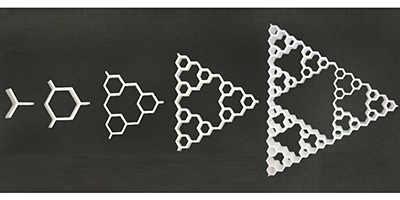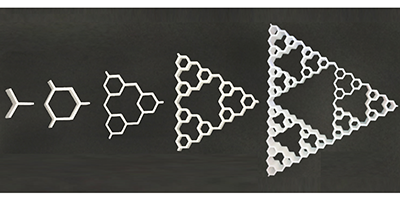Better than Bees
Hexagonal honeycomb structures, such as those found in beehives, are well known to exhibit remarkable mechanical properties, such as extremely high stiffness, relative to their very low density. Writing in Physical Review Letters, Ashkan Vaziri from Northeastern University, Boston, and colleagues, show that the mechanical properties of these uniform honeycomb structures could be even better if different levels of hierarchy are added in to form fractal materials. The research provides an easy route to enhance and tune the performance of the material by changing the details of its hexagonal structure, something that is becoming easier and easier to achieve with the advent of 3D printers.
To form the materials, Vaziri and his colleagues started out with a simple three-edged vertex network. Each three-edged vertex was then replaced with a hexagon. This process was repeated with smaller and smaller hexagons being added until the desired hierarchical order was achieved. The density was tuned by changing the thickness of the connecting walls. Guided by simulations, experiments were carried out for a set of 3D printed versions of the materials with varying density and hierarchies.
The authors studied how mechanical properties such as the elastic modulus (the material’s resistance to deformation) depended on various parameters. They found that, for a given density, the elastic modulus increased significantly with increasing hierarchical order, up to a point of saturation. Surprisingly, for a fixed hierarchy level, the modulus also increased with decreasing density. The resulting materials had moduli over times greater than hierarchy-free honeycomb structures. Using these results, the authors were able to make predictions for an optimal structure—in terms of material performance—needed to maximize strength at a specified material density. – Katherine Wright





